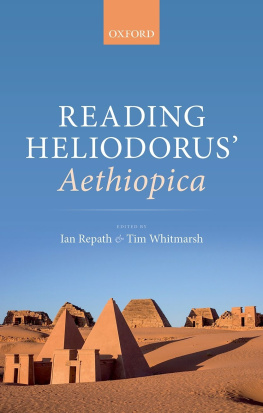Alain Billault is Professor of Greek Emeritus at Sorbonne Universit.
Ewen Bowie is Professor Emeritus at the University of Oxford and a Fellow Emeritus of Corpus Christi College.
Ken Dowden is Professor of Classics Emeritus at the University of Birmingham.
Jonas Grethlein is Professor of Greek Literature at Heidelberg University.
Richard Hunter FBA is Regius Professor of Greek Emeritus and Fellow of Trinity College, University of Cambridge.
Lawrence Kim is Professor of Classical Studies at Trinity University.
David Konstan is Professor of Classics at New York University.
Silvia Montiglio is Gildersleeve Professor of Classics at Johns Hopkins University.
Helen Morales is Argyropoulos Professor of Hellenic Studies at the University of California, Santa Barbara.
Michael Paschalis is Professor Emeritus at the University of Crete.
Ian Repath is Senior Lecturer at Swansea University.
Stephen M. Trzaskoma is Professor and Director of the Center for the Humanities at the University of New Hampshire.
Ruth Webb is Professor of Greek Language and Literature at the University of Lille.
Tim Whitmarsh FBA is A. G. Leventis Professor of Greek Culture at the University of Cambridge, and a Fellow of St Johns College.
Froma I. Zeitlin is Ewing Professor of Greek Language and Literature Emerita at Princeton University.
There was a time when scholars of Greek literature used to dismiss the Greek romances as easy reading to fatten up the intellectually moribund as they languished under the pax Romana. The romances, which themselves vary enormously in terms of sophistication and style, no doubt attracted a diverse readership; but there is no reason whatsoever to doubt that women and men of the highest intellectual sophistication found richness and depth in these texts. As Stephen M. Trzaskomas contribution to this volume shows, we are only now beginning to comprehend just how extensively the romance-writers shaped the world-view of those around them.
There are five romances that survive in full: Xenophons Ephesian Adventures of Anthia and Habrocomes and Charitons Callirhoe (both probably first century ce ), Achilles Tatius Leucippe and Clitophon (second century), Longus Daphnis and Chloe (second or third century), and Heliodorus Ethiopian Adventures of Charicleia and Theagenes (probably fourth century).
To read Longus text as a simple, sweet tale is an act of gross simplification, for sure; but history shows that it is quite possible to do so. To read Heliodorus Ethiopian Adventures of Charicleia and Theagenes (conventionally shortened to the Aethiopica) in this way, however, would be impossible. This is a labyrinthine text composed in arguably the most challenging prose of any ancient Greco-Roman literary writer. As Otto Mazal noted, Heliodorus extravagant syntax and bejewelled lexis mirror the complexities of his narrative.
Other ancient readers clearly shared modern readers impressions of Heliodorus as a challenging but rewarding stylist. In the eleventh century, in the early years of the Comnenian revival of the Byzantine Empire (which inspired a literary renaissance and a recovery of classical learning), the historian and philosopher Michael Psellos returned to the comparison between Heliodorus and Achilles. Like Photius, Psellos preferred Heliodorus on moral grounds, but he also observed the greater complexities. The Aethiopica, thought Psellos, is of loftier design, thanks to its innovative phrasing ( ); Heliodorus uses the arts of Isocrates and Demosthenes, famously grandiose writers (presumably the implication here is that Achilles, by contrast, follows the simple style of Lysias). But it is not just a question of style. Psellos also acknowledges (in colourful language) the narrative sophistication that recent scholars have done so much to expose:
At first the reader thinks that there is a lot of excess material; but as the story unfurls, he will marvel at the authors organization of his text ( ). The beginning of the text looks like coiled snakes, concealing their heads inside the nest while the rest of the body pokes out.
It is not just that Heliodorus begins in medias res, confusing the reader by withholding crucial information; it is also that multiple, unresolved plot lines appear almost simultaneously. Charicleia, Theagenes, Thyamis, Cnemon, Thisbe, Calasiris, and Nausicles are all introduced in the opening two books, and all have interesting backstories that are either partially or completely obscured at this early stage. Conversely, Psellos notes, Heliodorus makes the middle of the story into a beginning ( ). As with the Odyssey, to which the Aethiopica repeatedly looks, the narrative falls into two halves, a complex first one (with multiple plot lines and flashback narrative) and a more linear second one, during which the organization () becomes clear.
Ancient readers found Heliodorus fascinating for another reason. There are hints in the Aethiopica itself that invite an allegorical reading. and his reading reflects the way the text provokes multi-layered readings, of a kind which feature prominently in this volume.
For modern readers, the texts complexity takes its cue from its portrayal of character, particularly that of the priest Calasiris, who seems to combine high-minded virtue and duplicitousness in equal measure. Calasiris emerges from much modern scholarship as an Odyssean figure whose ambiguities model those of the text itself.

